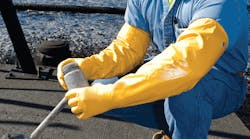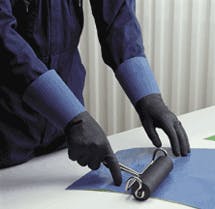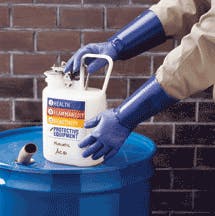There has been a shift in manufacturing operations, creating an even greater need for proper hand protection. Within the last 10 years, robotics and automated processes have taken over much of the handling, pouring and manipulation of hazardous chemicals in the industrial workplace. However, the risk of harm to workers' hands has not diminished.
In fact, this passive attitude toward hand protection from workplace chemicals may contribute to the major threat of hand injury. Users are not as eager to protect themselves, relying on machines to do this for them. In addition, workers often do not use the protective equipment that the specific task requires.
To further magnify the problem, the chemical retains its characteristics whether exposure comes from outright submersion or an incidental splash. Any skin contact – whether from a splash or from residual chemicals – can result in chemical burns. That exposure remains in almost every work environment where chemicals are used. At the same time, many jobs still require that workers pour chemicals into containers, apply chemicals manually, mix chemicals or transport chemicals and deal with accidental leakage on a daily basis.
For all of these reasons, it is essential that users don the proper protection, as there isn't a single glove that protects against the thousands of chemicals and chemical combinations to which workers may come in contact.
Tools for Effective Protection
With the magnitude of potential risk, how can EHS professionals choose the proper safety products to fulfill their PPE plan? Most safety managers look at online resources and metric tools to guide them and their employers toward the correct choice of chemical hand-protection products, in tandem with a tailored or customized hand-protection program built from an on-site assessment.
One of the first steps is to identify the issue through an on-site assessment to determine the right hand-protection program for each category. Some of the most effective programs have a three-step process (or similar):
1) The hand/arm safety assessment reviews the gamut of end-user applications beginning with a site survey. The goal is to correctly match hand-protection options with applications. Questions that may arise include:
• What gloves currently are being used?
• What are the costs associated with hand protection?
• What is the injury rate and cost of these injuries to the employer and employee in lost workdays, efficiency, etc.?
• What can be done to improve safety, efficiency and overall cost (short-, mid- and long-term)?
2) On-site technical training can be offered by experts within your organization, or manufacturers often will provide education for plant managers, site supervisors, shift managers and in some cases, individual employee teams. Ensuring that the correct information is disseminated is crucial for an effective hand-protection program to take hold.
3) Awareness and follow-up education is crucial. When a hand-protection program is ready for launch, creating awareness is key to its success. Leverage posts within your facility where employees gather (break rooms, cafeterias, locker rooms) and use them to post information about hand safety activities. Use email messages, printed signage and any other means of communication in order to ensure that the program is implemented and educate employees about why hand protection is important. Passive terms such as "should" are replaced with proactive ones such as "must," and proper guidelines must be met in order for any safety program to take hold and become an effective means for positive change.
Online Resources
There are thousands of chemical-resistant hand-protection products in the marketplace, with resources in such abundance that one may become challenged to find the right product. Fortunately, industrial glove manufacturers have developed online tools and on-site programs to help safety officers and employers make sound decisions in choosing chemical resistant gloves.
Butyl: High permeation resistance to gases and water vapors as well as highly corrosive acids, ketones and esters.
Natural rubber latex: Resistant against animal fats, caustics, acids, salts, alcohols and detergents.
Neoprene: Durable resistance against a wide range of chemicals as well as solvents and oils, especially acids and caustics and greases.
Nitrile: Durable resistance against a wide range of chemicals including oils, especially petrochemicals and fuels and most acids.
PVC: Durable resistance and barrier protection against some chemicals, especially petrochemicals, oils and grease.
Viton: Highest chemical resistance to aromatic hydrocarbons such as benzene, toluene and xylene.
Here is some information you will need to determine which gloves are necessary to protect your workers:
• What chemical are workers exposed to? One of the first contributing factors is the chemical or chemicals to which a user will come into contact.
• What is the exposure level? Is the exposure level heavy or limited? Check permeation times, which often are provided and ranked in order from the highest to lowest levels in which the glove material breaks down. This information is critical to choosing the correct product.
• What are the physical hazard risks for limited and heavy exposures? Do your chemical-resistant gloves also need to protect against abrasions, cuts, tears and puncture hazards?
Testing Standards
Testing standards are crucial to fueling the proper information into these online tools. It is essential to ensure that these standards are provided by proper global technical-safety organizations. Using American Society for Testing and Materials (ASTM) standard permeation and degradation tests, glove manufacturers regularly test swatches of gloves made of these materials in various chemicals. Gloves are rated for particular chemicals based on those tests. Additionally, glove packaging typically contains useful information on the recommended uses for the glove and the results of testing.
However exhaustive the search for the "perfect" gloves, every glove material has its limitations. It is important for workers to be aware of signs of permeation, penetration, degradation and contamination and the definitions of these terms:
Permeation: Permeation occurs when substances pass through the intact material of the glove at the molecular level. Permeation also is known as the "silent killer."
Penetration: Penetration occurs when a substance passes through a seam or damaged part of the glove, such as a pinhole or tear.
Degradation: Degradation occurs when a substance damages the material of the glove, making it less resistant. The end result is the physical breakdown of the polymer.
Contamination: Contamination occurs when the inside of the glove becomes contaminated throughout the wrist opening and gauntlet, most likely due to poor donning/doffing practices.
Often the ongoing effectiveness of a given glove can be determined by simple sensory tests: Does the material feel like it did originally or has it become brittle? Does the material smell like the chemical it is supposed to be protecting against, even after thorough rinsing or washing? Is the exterior of the glove intact? If the glove doesn't measure up, it's time to replace it.
The exposure of worker's hands to potentially harmful chemicals is a workplace risk that can be managed with on-site assessments, planning and execution. EHS professionals just need the right information to make sound decisions relating to their PPE plan.
Dave Shutt coordinates Showa Best Glove's new product development in general-purpose, disposable and chemical-resistant glove lines among research and development, field sales and marketing teams, as well as distributor and end-user customers. A 20-plus-year veteran of the glove industry, he holds a degree in business administration from Malone College and is a Carnegie graduate.


